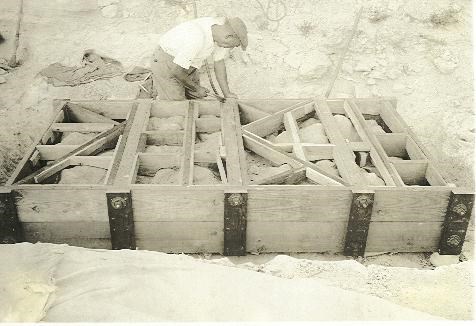
Most of the fossils in the Agate Springs quarries were found to have been excavated from a bonebed that could be as much as two feet thick. Among those fossilized bones, paleontologists discovered remains of long-extinct mammals such as Menoceras, Dinohyus, and Moropus. Less common but equally important discoveries included horse and bird bones, too. The overall density of the bones presented by unearthed material made it difficult for paleontologists - how would they remove fossils efficiently, and without distroying the precious fossils? Steps to Excavate Bone Slabs1. Remove the "Overburden"The first stage of the operation was to cut down the overlying rock to about two feet above the bone layer. This material is called the "overburden." This was done by methods that involved boring into the sandstone with drills and then blasting away the rock with dynamite. Field crews then used heavy picks, scrapers, and a team of horses to remove the debris. 2. Carefully Expose the Bone LayerNext, the more careful work of removing the sediment down to the bone layer began. Different tools were used here: light hand picks, awls and whisks followed by soft brushes to clean dirt away as the bones were exposed. The bone surfaces were soaked with thinned shellac varnish, especially on parts that were cracked or shattered. 3. Size Up the SlabWhen a large area had been exposed, the bones were studied and a decision made on how to take them out. If some of the lesser found Moropus or Dinohyus bones were lying with a mass of Menoceras bones, the latter may have been sacrificed in order to channel around the more valuable bones. The main intent was to reduce the size of the block of bonebed to a size that could be easily handled and transported; not over four or five feet square and one to two feet thick. 4. Cut Around and Under, then Wrap it UpAfter a narrow channel had been cut all around the block through the bone layer, it was undercut a bit and then bandaged. Several coats of shellac were applied and thoroughly dried in the hot sun before the bandaging began. Strips of burlap dipped in plaster of Paris were applied to the surface and then kneaded down to stick to the surface. The strips were laid parallel until the entire surface was covered, then a second set of strips were laid at right angles to the first. This formed a rigid and tough casing over the block and around the edges. 5. Finish Undercutting and Haul it OffThe block was further undercut sometimes using barbed wire as a cutting tool until the block was loose and could be carefully turned over. The underside was trimmed smooth, soaked with shellac and bandaged. When thoroughly dry, the block was boxed with lumber brought to the site for that purpose. Using skids or levers the block was lifted onto a wagon and hauled to the railroad station. Heavy blocks called for the use of a tripod with differential pulley or ropes and chains. 
Processing and Studying the Bone SlabsWhen the bone slab arrived at whichever museum or university the field crew worked for, the encased slab was opened and the fossils exposed. Each slab could take many years to carefully process down to the individual bones and trace fossils. The Agate Paleoriver watering hole yielded so much material, that many bone slabs are still not processed -- 100 years later! However, paleontologists estimate that 70 percent of the watering hole bone bed is still unexcavated within the Fossil Hills. Some of the institutions with slabs from Agate Fossil Beds are:
|
Last updated: March 18, 2024
